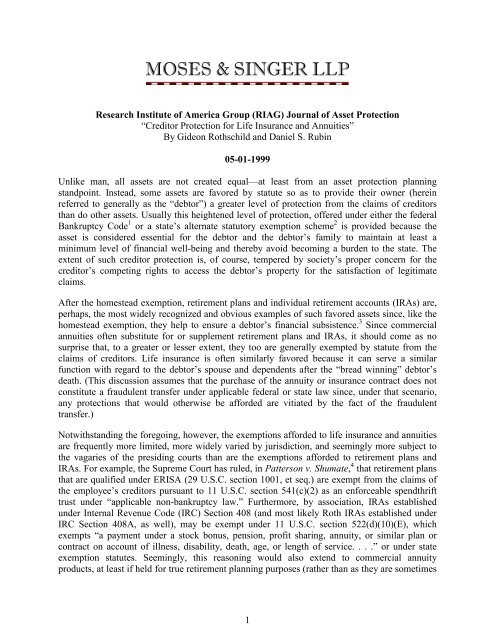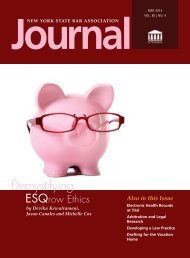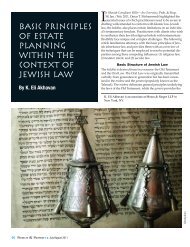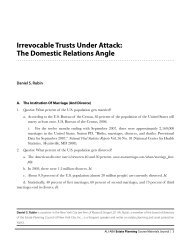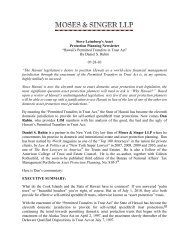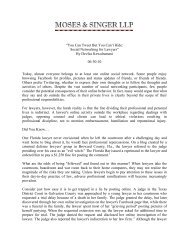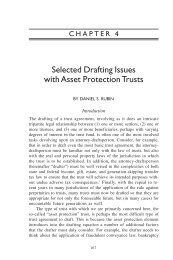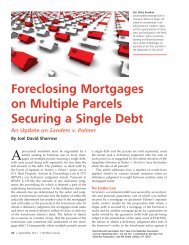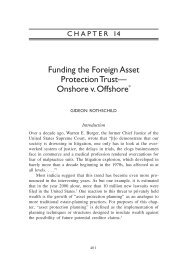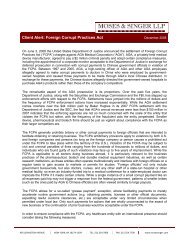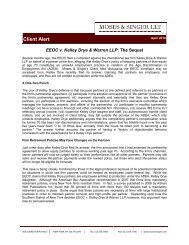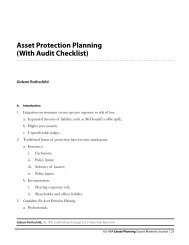Creditor Protection for Life Insurance and Annuities
Creditor Protection for Life Insurance and Annuities
Creditor Protection for Life Insurance and Annuities
Create successful ePaper yourself
Turn your PDF publications into a flip-book with our unique Google optimized e-Paper software.
Research Institute of America Group (RIAG) Journal of Asset <strong>Protection</strong><br />
“<strong>Creditor</strong> <strong>Protection</strong> <strong>for</strong> <strong>Life</strong> <strong>Insurance</strong> <strong>and</strong> <strong>Annuities</strong>”<br />
By Gideon Rothschild <strong>and</strong> Daniel S. Rubin<br />
05-01-1999<br />
Unlike man, all assets are not created equal—at least from an asset protection planning<br />
st<strong>and</strong>point. Instead, some assets are favored by statute so as to provide their owner (herein<br />
referred to generally as the “debtor”) a greater level of protection from the claims of creditors<br />
than do other assets. Usually this heightened level of protection, offered under either the federal<br />
Bankruptcy Code 1 or a state’s alternate statutory exemption scheme 2 is provided because the<br />
asset is considered essential <strong>for</strong> the debtor <strong>and</strong> the debtor’s family to maintain at least a<br />
minimum level of financial well-being <strong>and</strong> thereby avoid becoming a burden to the state. The<br />
extent of such creditor protection is, of course, tempered by society’s proper concern <strong>for</strong> the<br />
creditor’s competing rights to access the debtor’s property <strong>for</strong> the satisfaction of legitimate<br />
claims.<br />
After the homestead exemption, retirement plans <strong>and</strong> individual retirement accounts (IRAs) are,<br />
perhaps, the most widely recognized <strong>and</strong> obvious examples of such favored assets since, like the<br />
homestead exemption, they help to ensure a debtor’s financial subsistence. 3 Since commercial<br />
annuities often substitute <strong>for</strong> or supplement retirement plans <strong>and</strong> IRAs, it should come as no<br />
surprise that, to a greater or lesser extent, they too are generally exempted by statute from the<br />
claims of creditors. <strong>Life</strong> insurance is often similarly favored because it can serve a similar<br />
function with regard to the debtor’s spouse <strong>and</strong> dependents after the “bread winning” debtor’s<br />
death. (This discussion assumes that the purchase of the annuity or insurance contract does not<br />
constitute a fraudulent transfer under applicable federal or state law since, under that scenario,<br />
any protections that would otherwise be af<strong>for</strong>ded are vitiated by the fact of the fraudulent<br />
transfer.)<br />
Notwithst<strong>and</strong>ing the <strong>for</strong>egoing, however, the exemptions af<strong>for</strong>ded to life insurance <strong>and</strong> annuities<br />
are frequently more limited, more widely varied by jurisdiction, <strong>and</strong> seemingly more subject to<br />
the vagaries of the presiding courts than are the exemptions af<strong>for</strong>ded to retirement plans <strong>and</strong><br />
IRAs. For example, the Supreme Court has ruled, in Patterson v. Shumate, 4 that retirement plans<br />
that are qualified under ERISA (29 U.S.C. section 1001, et seq.) are exempt from the claims of<br />
the employee’s creditors pursuant to 11 U.S.C. section 541(c)(2) as an en<strong>for</strong>ceable spendthrift<br />
trust under “applicable non-bankruptcy law.” Furthermore, by association, IRAs established<br />
under Internal Revenue Code (IRC) Section 408 (<strong>and</strong> most likely Roth IRAs established under<br />
IRC Section 408A, as well), may be exempt under 11 U.S.C. section 522(d)(10)(E), which<br />
exempts “a payment under a stock bonus, pension, profit sharing, annuity, or similar plan or<br />
contract on account of illness, disability, death, age, or length of service. . . .” or under state<br />
exemption statutes. Seemingly, this reasoning would also extend to commercial annuity<br />
products, at least if held <strong>for</strong> true retirement planning purposes (rather than as they are sometimes<br />
1
marketed—as a tax-favored investment vehicle), but significant issues remain.<br />
Notwithst<strong>and</strong>ing these factors, the potential value of such exemptions to a debtor or potential<br />
debtor means that the exemptions warrant a careful <strong>and</strong> considered review by both asset<br />
protection planners <strong>and</strong> bankruptcy counsel acting in a pre-bankruptcy planning function.<br />
(Although <strong>for</strong>eign life insurance <strong>and</strong> annuity products may offer more protection from creditors<br />
than do their domestic counterparts, such products are beyond the scope of this article.)<br />
<strong>Life</strong> <strong>Insurance</strong><br />
Consideration of the potential creditor protections af<strong>for</strong>ded to life insurance contracts is<br />
complicated by the several capacities in which the debtor may have an interest in the policy. For<br />
example, the debtor can be the owner of the policy, the insured, or both the owner <strong>and</strong> the<br />
insured. Alternatively the debtor may be the beneficiary of the policy or the owner of a policy<br />
that names his or her estate as the beneficiary of the policy. To further complicate matters, since<br />
the exemptions af<strong>for</strong>ded to life insurance are intended to further particular public policy goals<br />
(i.e., protecting the debtor’s dependents from financial destitution in the event of the debtor’s<br />
untimely demise), the relationships between the owner <strong>and</strong> the insured <strong>and</strong> between the owner<br />
<strong>and</strong> the beneficiary are often key to determining whether <strong>and</strong> to what extent the particular life<br />
insurance policy at issue may be protected from creditor claims. These additional permutations<br />
exponentially increase the complexity of determining whether the life insurance policy may be<br />
exempted in any particular circumstance.<br />
The federal bankruptcy exemptions <strong>for</strong> life insurance policies owned by the debtor are found at<br />
11 U.S.C. sections 522(d)(7) <strong>and</strong> (8), where their relative importance to the average person is,<br />
perhaps, evidenced by their placement between the exemptions <strong>for</strong> the debtor’s professional<br />
books <strong>and</strong> tools of the trade <strong>and</strong> the debtor’s professionally prescribed health aids. More<br />
specifically, the federal bankruptcy exemptions <strong>for</strong> life insurance shield unmatured policies<br />
owned by the debtor (other than a credit life insurance contract) 5 <strong>and</strong> up to $8,625 6 of the<br />
debtor’s aggregate interest in any accrued dividend or interest under, or loan value of, an<br />
unmatured life insurance contract, provided that the insured is either the debtor or an individual<br />
of whom the debtor is a dependent. 7 Since, however, federal bankruptcy law broadly defines a<br />
dependent as including a spouse, regardless of whether the debtor’s spouse is actually dependent<br />
on the debtor, the exemption will apply without further inquiry so long as either the debtor or the<br />
debtor’s spouse is the insured. 8<br />
The effect of the <strong>for</strong>egoing exemption is to protect the actual insurance element of the policy <strong>and</strong><br />
little else, since only a minimal portion of the cash surrender value of the policy is af<strong>for</strong>ded any<br />
exemption. While the exemption of an unmatured life insurance contract without the exemption<br />
of the cash surrender value may prove invaluable in certain limited circumstances (<strong>for</strong> example,<br />
if the debtor has become uninsurable since the life insurance policy was originally purchased), it<br />
obviously does not provide significant opportunities <strong>for</strong> asset protection or pre-bankruptcy<br />
planning <strong>for</strong> the insured.<br />
That the primary intent of the Bankruptcy Code as it relates to the exemption of life insurance is<br />
to protect a dependent’s interest in the life insurance policy, rather than the owner’s own interest,<br />
is further supported by 11 U.S.C. section 522(d)(11)(C). That section concerns the debtor as the<br />
2
eneficiary of the policy (rather than as the owner of the policy) <strong>and</strong> exempts the debtor’s<br />
entitlement to the proceeds of a life insurance contract, without any specific dollar limitation, to<br />
the extent that such proceeds are “reasonably necessary” <strong>for</strong> the support of the debtor <strong>and</strong> any<br />
dependent of the debtor. For the exemption to apply the debtor has to have been a dependent of<br />
the insured at the time of the insured’s death.<br />
Since the federal exemption scheme <strong>for</strong> life insurance that is owned by the debtor is so<br />
parsimonious, if an exemption under an alternative state scheme is provided, it should be<br />
carefully considered. Following the model of the federal exemption scheme, some states provide<br />
very limited exemptions <strong>for</strong> the cash surrender value of life insurance. For example, South<br />
Carolina offers only a $4,000 exemption <strong>for</strong> the cash surrender value of life insurance (again,<br />
provided that the insured is either the debtor or an individual on whom the debtor is dependent). 9<br />
Proceeds payable to the insured’s spouse, children, or dependents are, however, generally fully<br />
exempt from the creditors of the insured. 10 Wisconsin also exempts only $4,000 (provided that<br />
the insured is either the debtor, a dependent of the debtor, or an individual on whom the debtor is<br />
dependent). 11 If the debtor is the beneficiary of the life insurance policy, however, <strong>and</strong> provided<br />
that the debtor was dependent on the insured, Wisconsin law exempts payments to the extent<br />
reasonably necessary <strong>for</strong> the support of the debtor <strong>and</strong> the debtor’s dependents. 12<br />
Other states, however, have exemption schemes that provide <strong>for</strong> far greater protection of the cash<br />
surrender value of life insurance policies than does the federal exemption scheme. For example,<br />
in keeping with its generally pro-debtor stance, Florida specifically exempts the entire cash<br />
surrender value of life insurance policies from the reach of creditors 13 <strong>and</strong> the entire death<br />
benefit from the creditors of the insured. 14 Hawaii similarly specifically exempts the entire death<br />
benefit <strong>and</strong> cash surrender value of life insurance policies from the reach of creditors of the<br />
owner of the life insurance policy, provided, however, that the policy is payable to a spouse of<br />
the insured, or to a child, parent, or other person dependent on the insured, except as to<br />
premiums paid in fraud of creditors. 15 Louisiana also specifically exempts the entire proceeds<br />
(including the full cash surrender value) of life insurance policies from the reach of creditors.<br />
The exemption is, however; limited to $35,000 of the cash surrender value if the life insurance<br />
policy was issued within nine months of a bankruptcy filing. 16 Exhibit 1 contains a state-by-state<br />
tabulation of the exemptions.<br />
New York’s scheme <strong>for</strong> the exemption of life insurance 17 is worth noting because it clearly<br />
distinguishes between the several permutations which can result depending on whether the<br />
debtor is the owner of the policy (referred to under the New York statute as the person “effecting<br />
the policy,” <strong>and</strong> need not be the person who actually purchased the policy), the insured, the<br />
beneficiary, or some combination thereof. More specifically, the New York State exemption<br />
scheme <strong>for</strong> life insurance provides that: 18<br />
1. If the owner of a life insurance policy insures his or her own life <strong>for</strong> the benefit of<br />
another (i.e., a beneficiary other than the owner’s estate), that other person shall be entitled to the<br />
proceeds <strong>and</strong> avails of the policy as against the creditors of the owner. (In other words, the<br />
beneficiary’s interest in a life insurance policy owned by another is protected from claims of the<br />
policy owner’s creditors, notwithst<strong>and</strong>ing the fact that a power to change the beneficiaries of the<br />
life insurance policy has been reserved.)<br />
3
2. If the owner of a life insurance policy insures the life of another <strong>for</strong> the owner’s<br />
own benefit, the owner is entitled to the proceeds <strong>and</strong> avails of the policy as against the creditors<br />
of the insured. (In other words, the interest of an owner of life insurance in the policy is protected<br />
from the creditors of the insured).<br />
3. If the owner of a life insurance policy insures the life of his or her spouse <strong>for</strong> the<br />
owner’s own benefit, the owner is also entitled to the proceeds <strong>and</strong> avails of the policy as against<br />
his or her own creditors. (In other words, the interest of an owner/beneficiary of life insurance in<br />
the policy is protected from the owner/beneficiary’s own creditors if the insured is the owner’s<br />
spouse).<br />
4. If the owner of a life insurance policy insures the life of another person <strong>for</strong> the<br />
benefit of a third party, the third party is entitled to the proceeds <strong>and</strong> avails of the policy as<br />
against the creditors of both the owner <strong>and</strong> the insured. (In other words, the beneficiary’s interest<br />
in a life insurance policy is protected from claims of the creditors of both the owner of the policy<br />
<strong>and</strong> the insured).<br />
5. The owner of a life insurance policy, regardless of the identity of the insured, is<br />
entitled to accelerated payment of the death benefit or accelerated payment of a special surrender<br />
value permitted under such policy as against the creditors of the owner. (In other words, the<br />
owner’s interest in the cash surrender value of a life insurance policy is protected from claims of<br />
the owner’s own creditors).<br />
Even the extensive New York exemption statute does not, however, cover all possible<br />
permutations. For example, in Dellefield v. Block, 19 a husb<strong>and</strong> took out two paid-up life<br />
insurance policies on his own life with his wife as beneficiary.<br />
Thereafter, both the husb<strong>and</strong> <strong>and</strong> his wife became debtors of the same judgment creditor. Since<br />
the law in effect at that time provided that a life insurance policy insuring the owner’s own life<br />
<strong>for</strong> the benefit of another is protected from the owner’s creditors, but did not then expressly<br />
provide that the same life insurance policy is protected from the debtor beneficiary’s own<br />
creditors, the novel issue arose as to whether a joint judgment creditor could en<strong>for</strong>ce its judgment<br />
against the life insurance policies. Based on a liberal interpretation of legislative intent to the<br />
effect that the statutory exemption of the debtor/owner’s interest was intended to protect all cases<br />
in which a person invested his or her own money to insure his or her own life <strong>for</strong> the benefit of<br />
another, the Dellefield court held that the life insurance policies could not be reached by the<br />
parties’ joint judgment creditor.<br />
Other issues, of course, exist as well. For example, in the New York statute, the phrase “proceeds<br />
<strong>and</strong> avails” is defined to include “. . . death benefits, cash surrender <strong>and</strong> loan values, premiums<br />
waived, <strong>and</strong> dividends, whether used in reduction of premiums or in whatever manner used or<br />
applied, except where the debtor has, after issuance of the policy, elected to receive the dividends<br />
in cash.” 20 Unlike New York, however, not all state statutes expressly define which incidents of<br />
value of a life insurance policy (i.e., specifically the debtor’s ability to shield the cash surrender<br />
value of a life insurance policy versus the debtor’s entitlement to the proceeds of a matured<br />
policy on the life of another) are covered by the exemption scheme at issue. There<strong>for</strong>e, the issue<br />
may arise as to whether <strong>and</strong> to what extent the cash surrender value may be exempted when the<br />
4
statute refers only to “monies paid out of a life insurance policy” or similarly ambiguous<br />
language. In this regard, in In re Worthington, a bankruptcy court, interpreting a Kentucky<br />
exemption statute that provided simply that “[a]ny money or other benefit to be paid or rendered<br />
by any assessment or cooperative life or casualty insurance company is exempt from execution<br />
or other process” 22 determined that an unlimited exemption was provided <strong>for</strong> the cash surrender<br />
value of life insurance policies. The Worthington 21 court stated that:<br />
This statute does not restrict “any money or other benefit to be paid . . . ” as<br />
exemptible only upon death but rather it denotes an exemption extending to the<br />
debtor on any monetary value or benefits accruing by virtue of ownership. Thus,<br />
the loan values or the cash surrender values by virtue of the enactment of the<br />
Kentucky Legislature have been deemed exempt since the term “any money . . . to<br />
be paid” is not restricted as to time of election <strong>and</strong> offers no alternative but to<br />
include the cash surrender value within its definition. . . . The Kentucky<br />
legislature has, after due deliberation <strong>and</strong> in its wisdom, determined that any<br />
monetary value in life insurance policies owned by its citizens is exempt without<br />
monetary limitation. . . . 23<br />
Similarly, it has been held that when reference is made to the “proceeds <strong>and</strong> avails” of a life<br />
insurance policy, such reference comprehends the protection of cash surrender values <strong>and</strong> other<br />
values built up during the life of the policy as well as the protection of its death benefit, even if<br />
not expressly so provided by statute. 24 Notwithst<strong>and</strong>ing the express unlimited exemption that<br />
exists in some states, however, the actual use of such an exemption may have the unintended<br />
effect of reducing the debtor’s general exemption <strong>for</strong> personal property.<br />
The fact that the unlimited exemption <strong>for</strong> the cash surrender value of life insurance that exists in<br />
some states can be abused by dishonest debtors has been considered by the bankruptcy court <strong>and</strong><br />
appropriately disregarded as a basis <strong>for</strong> judicially recasting the import of the exemption statutes.<br />
For example, in In re White, 25 the bankruptcy trustee, objecting to the debtor’s argument that the<br />
cash surrender value of his life insurance policy should be exempted as part of the unlimited<br />
exemption <strong>for</strong> the “proceeds <strong>and</strong> avails” of life insurance referred to under West Virginia’s<br />
exemption statute, poignantly argued that to hold the cash surrender value exempt would:<br />
. . . provide a debtor with an avenue <strong>for</strong> depositing his funds, in unlimited<br />
amounts, in a species of property which would place it beyond the reach of his<br />
creditors, but not beyond his own reach after his discharge in bankruptcy.<br />
Similarly in In re Beckman, 26 the bankruptcy trustee argued that to hold the cash surrender value<br />
of the debtor’s life insurance policy exempt would be to make an insurance policy “a refuge <strong>for</strong><br />
fraud.” In each case, however, the bankruptcy court responded by stating that such an argument<br />
overlooks the fact that the exemption statute expressly provides that premiums paid in fraud of<br />
creditors would, nevertheless, inure to the benefit of creditors. In any event, “. . . [i]f abuses to<br />
enacted exemptions are deemed to exist, the remedy is by other than judicial legislation.” Such<br />
reasoning would seem to exempt even single premium policies purchased as a safe harbor <strong>for</strong><br />
otherwise non-exempt funds; provided, however, that it cannot be proven that the single<br />
premium payment constituted a fraudulent transfer.<br />
5
There<strong>for</strong>e, <strong>for</strong> the residents of certain states at least, valuable asset protection <strong>and</strong> pre-bankruptcy<br />
planning opportunities exist using life insurance policies; provided, as always, that the<br />
conversion of non-exempt assets into exempt assets (be they cash surrender value life insurance<br />
policies or otherwise) is not made with the intent to hinder, delay, or defraud creditors. (The<br />
reorganization of a debtor’s holdings into exempt assets prior to bankruptcy <strong>for</strong> the purpose of<br />
shielding such assets from creditors is generally held to be acceptable pre-bankruptcy planning<br />
rather than transfers fraudulent as to creditors.)<br />
Notwithst<strong>and</strong>ing the <strong>for</strong>egoing, however, the greatest protection <strong>for</strong> life insurance exists<br />
irrespective of the exemptions af<strong>for</strong>ded by applicable law, relying instead on traditional (<strong>and</strong> not<br />
so traditional) estate planning techniques. For example, the owner of the policy (the settlor) may<br />
transfer his or her policies to an irrevocable spendthrift trust (or even better, the settlor can create<br />
an irrevocable spendthrift trust to acquire the life insurance policy in the first instance), thereby<br />
protecting the value of the life insurance policy not only from creditors (both those of the settlor<br />
<strong>and</strong> those of the trust beneficiaries, <strong>and</strong> regardless of their relationship to each other or to the<br />
insured), but from taxation in the settlor’s estate as well under IRC Section 2042. IRC Section<br />
2035(a)(2), however, includes in the settlor’s gross estate the proceeds of any life insurance<br />
policies that were transferred within the three-year period ending on the date of the settlor’s<br />
death. At the same time, there is little doubt that section 541(c)(2) of the Bankruptcy Code would<br />
also serve to exclude the trust property from the settlor/debtor’s bankruptcy estate as a<br />
spendthrift trust en<strong>for</strong>ceable under applicable non-bankruptcy law.<br />
Furthermore, the transfer of life insurance policies to an irrevocable life insurance trust need not<br />
place the potential benefit of the cash surrender value of such policies beyond the settlor’s reach.<br />
A married settlor can name his or her spouse as a discretionary beneficiary of the trust <strong>and</strong>,<br />
there<strong>for</strong>e, to the extent that the trustees are amenable to making a distribution of property out of<br />
the trust to the spouse of the settlor, the settlor can attain an indirect benefit from the trust<br />
property <strong>for</strong> so long as the spouse survives. If, however, the settlor is unmarried, or if the settlor<br />
is concerned with the possibility that his or her spouse may be the first of the pair to die, the<br />
settlor can establish the trust under the laws of Alaska or Delaware (or, alternatively, under the<br />
law of certain, select, off-shore jurisdictions such as the Cook Isl<strong>and</strong>s), since the law of each of<br />
those jurisdictions provides that the owner of property (including life insurance policies) can<br />
create a discretionary trust <strong>for</strong> his or her own benefit without leaving the transferred property<br />
subject to the claims of his or her creditors. (There may, however, be a risk of creditor<br />
attachment in such a self-settled trust if the assets are within the U.S. court’s jurisdiction.)<br />
Through the interaction between Chapters 11, 12, <strong>and</strong> 13 of the IRC <strong>and</strong> local law governing<br />
creditors’ rights, the death benefit of the life insurance policy will most likely be excluded from<br />
the settlor’s gross estate <strong>for</strong> transfer tax purposes, notwithst<strong>and</strong>ing the fact that the settlor can<br />
benefit from the cash surrender value of the policy during the settlor’s lifetime. 27<br />
<strong>Annuities</strong><br />
The federal bankruptcy exemption <strong>for</strong> annuity payments is found at 11 U.S.C. section<br />
522(d)(10)(E). Like the federal exemption <strong>for</strong> the cash surrender value of life insurance policies,<br />
the exemption <strong>for</strong> the right to receive an annuity is not overly generous <strong>and</strong> does not lend itself to<br />
asset protection or pre-bankruptcy planning. Specifically, the federal exemption <strong>for</strong> the right to<br />
receive an annuity provides that payments may be exempted only if payable by reason of “. . .<br />
6
illness, disability, death, age, or length of service . . . ” <strong>and</strong> even then, only to the extent<br />
“reasonably necessary” <strong>for</strong> the support of the debtor <strong>and</strong> any dependent of the debtor. There<strong>for</strong>e,<br />
planning opportunities under the federal exemption <strong>for</strong> the right to receive an annuity are limited<br />
because of the requirement that the annuitant be ill, aged, dead, or have per<strong>for</strong>med a certain<br />
length of service. Even if the debtor was the beneficiary of such a <strong>for</strong>tuitously placed annuity, the<br />
exemption of the payments to be received by the debtor would most likely be subject to litigation<br />
to resolve whether they are in an amount required under the exemption’s “reasonably necessary”<br />
st<strong>and</strong>ard. While the “reasonably necessary” st<strong>and</strong>ard is sensitive to the debtor’s particular<br />
situation, the courts have generally proven extremely spare in applying the exemption under such<br />
st<strong>and</strong>ard. In Warren v. Taff, 28 the court stated that “[t]he reasonably necessary st<strong>and</strong>ard requires<br />
that the court take into account other income <strong>and</strong> exempt property of the debtor, present <strong>and</strong><br />
anticipated . . . the appropriate amount to be set aside <strong>for</strong> the debtor ought to be sufficient to<br />
sustain basic needs, not related to [the debtor’s] <strong>for</strong>mer status in society or the lifestyle to which<br />
[the debtor] is accustomed. . . .” In In re Hunsucker, 29 <strong>for</strong> example, a 57-year-old teacher’s aide<br />
was allowed to exempt a commercial annuity when her anticipated teacher’s retirement benefits<br />
were only $50 per month.<br />
State law exemptions <strong>for</strong> the right to receive an annuity, on the other h<strong>and</strong>, vary greatly from one<br />
state to another, but generally align with the state’s exemption <strong>for</strong> the cash value of life insurance<br />
policies. Florida, <strong>for</strong> example, exempts the proceeds of annuity contracts without limitation. In<br />
contrast to Florida, Pennsylvania generally permits the exemption of only $100 per month of the<br />
proceeds of an annuity, 30 <strong>and</strong> North Carolina does not appear to permit the exemption of the<br />
proceeds of an annuity to any extent. Still other states, such as Missouri, follow the federal<br />
scheme <strong>and</strong> exempt only so much of an annuity as may be “reasonably necessary” <strong>for</strong> the<br />
support of the debtor <strong>and</strong> the debtor’s dependents. 31 New York’s exemption <strong>for</strong> annuities at first<br />
seems to follow that of the Florida model in that it initially provides that “[t]he benefits, rights,<br />
privileges <strong>and</strong> options which, under any annuity contract are due or prospectively due the<br />
annuitant, who paid the consideration <strong>for</strong> the annuity contract, shall not be subject to<br />
execution.” 32 Un<strong>for</strong>tunately the New York exemption statute goes on to provide that:<br />
. . . the court may order the annuitant to pay to a judgment creditor or apply on the<br />
judgment in installments, a portion of such benefits that appears just <strong>and</strong> proper to<br />
the court, with due regard <strong>for</strong> the reasonable requirements of the judgment debtor<br />
<strong>and</strong> his family, if dependent upon him. . . . 33<br />
Moreover, the New York exemption <strong>for</strong> the right to receive an annuity is further qualified by<br />
New York Debtor <strong>and</strong> <strong>Creditor</strong> Law § 283(1), which generally provides that the exemption <strong>for</strong><br />
annuity contracts initially purchased by the debtor within six months of the debtor’s bankruptcy<br />
filing are capped at $5,000, irrespective of the reasonable income requirements of the debtor <strong>and</strong><br />
his or her dependents. The intent of this latter section of the statute, according to the bankruptcy<br />
court in In re Moore, 34 is to “. . . limit the debtor’s ability to deliberately ‘load up’ on exempt<br />
property” Exhibit 1 contains a state-by-state tabulation of the exemptions.<br />
In states where the exemption <strong>for</strong> the right to receive an annuity is unlimited, litigation has<br />
centered around the issue of whether the interest held by the debtor is, in fact, an annuity under<br />
the exemption statute at h<strong>and</strong>. In Florida, at least, the courts have broadly construed the scope of<br />
the term to maintain the breadth of the exemption. For example, in In re McCollam, 35 the court<br />
7
held that under the Florida exemption scheme, an annuity received by the debtor pursuant to a<br />
structured settlement of her deceased father’s wrongful death claim was exempt as an annuity<br />
rather than non-exempt as the equivalent of an account receivable by the debtor. The court was<br />
expressly cognizant of the fact that a literal interpretation of the exemption statute would permit<br />
the debtor to conceal her award as an asset, but stated that “. . . had the legislature intended to<br />
limit the exemption to particular annuity contracts, it would have included such restrictive<br />
language when the statute was amended to include annuity contracts.” In contrast, however, the<br />
bankruptcy court in In re Pizzi 36 held that the annual payment of a debtor’s lottery winnings<br />
through a commercial annuity purchased by the state <strong>for</strong> the purpose of ensuring payment of the<br />
debtor’s lottery winnings was not exempt from the bankruptcy estate as an annuity under Florida<br />
law. Seemingly the Pizzi court allowed <strong>for</strong>m to prevail over substance since the defining feature<br />
of the case to the Pizzi court was the fact that the state was named the beneficiary of the annuity<br />
contract <strong>for</strong> the purpose of ensuring the payment of the lottery winnings to the debtor over time<br />
rather than the debtor having been named individually on the annuity contract. Interestingly the<br />
court noted, in dicta, that under Florida law “. . . the purpose <strong>and</strong> nature of an annuity is<br />
irrelevant if the contract fits within the broad definition of an annuity contract,” <strong>and</strong> then went on<br />
to state that had the state named the debtor as the beneficiary of the annuity contract, the<br />
payments would have fallen within the purview of the Florida exemption statute <strong>and</strong> been<br />
exempt. The court in Solomon v. Guardian <strong>Life</strong> <strong>Insurance</strong> Co. of America, 37 declined to follow<br />
the bankruptcy court’s reasoning of In re Pizzi, <strong>and</strong> held that “. . . not only annuities in the nature<br />
of retirement instruments can be exempted under § 222.14 but also debts structured as annuities.”<br />
Holding that the debtor could not exempt her stream of payments under an equitable distribution<br />
arrangement, the court in In re Conner 38 stated, “[t]he critical distinction between this case <strong>and</strong><br />
the cases cited by the parties is that the contract in those cases is identified as an annuity within<br />
the four corners of the contract.”<br />
In re Mart 39 took the broad definition of an annuity under Florida’s exemption scheme one step<br />
further. Here, the debtor’s daughter-in-law established an irrevocable trust <strong>for</strong> the benefit of<br />
seven children, nieces <strong>and</strong> nephews of the debtor, <strong>and</strong> minimally funded the trust with $2,000.<br />
The debtor’s daughter was appointed as trustee of the trust. The day after the trust was created,<br />
the debtor <strong>and</strong> his spouse entered into an annuity agreement with their daughter as trustee. In<br />
furtherance of the annuity agreement, the debtor <strong>and</strong> his spouse transferred $350,000 to the trust<br />
in exchange <strong>for</strong> a return stream of annuity payments of $3,000 per month. Thirteen months later,<br />
the debtor filed bankruptcy <strong>and</strong> claimed that the annuity was exempt under Fla. Stat. § 222.14.<br />
Substantively identical to the arguments made with regard to the unlimited exemption of the cash<br />
surrender value of life insurance by the creditors in In re White, 40 the objecting creditors argued<br />
that:<br />
. . . if (the debtor’s income stream from the transfer of this property is an Annuity,<br />
any debtor can go to his cousin <strong>and</strong> give him all of his property in return <strong>for</strong> a<br />
promised stream of income. That debtor need only pull out his big rubber stamp<br />
with the word Annuity on it <strong>and</strong> label the agreement from his cousin to pay the<br />
money.<br />
Notwithst<strong>and</strong>ing the piquancy of this argument, <strong>and</strong> like its predecessor in In re White, the<br />
bankruptcy court in In re Mart dismissed this argument to find in favor of the debtor. In re Mart,<br />
however, gave more of an explanation of its reasoning than did In re White, stating that:<br />
8
I agree that this statutory exemption, perhaps like all exemptions, invites abuse. I<br />
also agree that the debtor’s relationship with the . . . trustee, her evident<br />
willingness to accept her father’s proposals, <strong>and</strong> the fact that this is a completely<br />
private arrangement are grounds <strong>for</strong> careful scrutiny. . . . I reject the argument <strong>and</strong><br />
the objections, however, because, (1) . . . the statutory exemption is not restricted<br />
to annuities provided by completely unrelated, public entities, <strong>and</strong> (2) I find no<br />
intent to defraud creditors in this debtor’s conversion of his non-exempt assets to<br />
exempt assets through the establishment of this annuity contract.<br />
In contrast, the court in In re Gefen, 41 determined that the debtor’s conversion of a non-exempt<br />
individual retirement account to an annuity with an intent to defraud creditors was a fraudulent<br />
transfer voidable under the Florida statute.<br />
Like life insurance, the exemption <strong>for</strong> the right to receive an annuity is provided under applicable<br />
federal <strong>and</strong> state law <strong>for</strong> a particular purpose; to allow persons to ensure their retirement savings<br />
through vehicles peculiarly structured to provide an income stream during retirement (i.e., the<br />
minimum distributions required <strong>for</strong> ERISA qualified plans <strong>and</strong> IRAs, or the delayed lifetime<br />
income stream provided by the traditional annuity). In the past, annuity contracts were generally<br />
held by government workers <strong>and</strong> the employees of not-<strong>for</strong>-profit institutions (<strong>for</strong> example, the<br />
Teachers’ <strong>Insurance</strong> <strong>and</strong> Annuity Association (TIAA-CREF), which is one of the country’s<br />
largest providers of annuities) <strong>for</strong> whom other retirement plans were unavailable, as well as by<br />
those retirees who chose to receive distributions from other retirement plans in the <strong>for</strong>m of an<br />
annuity rather than via a “roll-over” into an IRA. More recently however, commercial annuities<br />
(such as variable annuity contracts) are being purchased by individuals purely as a tax-favored<br />
investment vehicle without any view towards the annuity’s traditional use <strong>for</strong> retirement savings.<br />
Such products were most likely never intended to be exempt <strong>and</strong> a colorable argument can be<br />
made by creditors to the effect that such products should not be held exempt, notwithst<strong>and</strong>ing<br />
that they are, in fact, annuities.<br />
A similar issue arises when a debtor converts non-exempt assets into an exempt annuity shortly<br />
prior to bankruptcy since the purpose of such conversion is likely less to provide <strong>for</strong> retirement<br />
needs than to “avoid” creditors (although not necessarily with any noisome connotation). In In re<br />
Johnson, 42 the debtor, a physician, personally guaranteed $19 million of the obligations of a<br />
corporation of which he was a 2% share-holder. Following the corporation’s default on the<br />
obligations, judgments were entered against the debtor on his guarantees. Thereafter, on the<br />
advice of counsel, <strong>and</strong> in furtherance of what the bankruptcy court termed “bankruptcy estate<br />
planning with a vengeance,” the debtor liquidated most of his non-exempt assets <strong>and</strong> purchased,<br />
inter alia, an annuity with a face value approximating $250,000. In finding that the debtor’s<br />
specific intent to put all of his rather substantial personal wealth beyond the reach of his business<br />
creditors pursuant to the Minnesota exemption scheme did not void the exemption of the debtor’s<br />
annuity interests, the Johnson court recognized that “[t]he gut level difficulty with the case at bar<br />
stems both from the massive amounts of money involved <strong>and</strong> from debtor’s status as an affluent<br />
physician enjoying sound professional status, excellent current income, <strong>and</strong> unlimited future<br />
earning potential.” Nevertheless, the Johnson court denied the bankruptcy trustee’s motion to<br />
deny the debtor a discharge. According to the court:<br />
. . . what is truly blame-worthy about a debtor’s intentional resort to “bankruptcy<br />
9
estate planning,” st<strong>and</strong>ing alone? From a purely legal perspective, <strong>and</strong> only in the<br />
context of an objection to discharge, the answer is “nothing”—at least where the<br />
debtor has not perpetrated actual fraud on a creditor, creditors, receiver, trustee, or<br />
other party in interest during the process. . . . The case law in this Circuit has long<br />
recognized the principle noted in the legislative history—that the pre-petition<br />
conversion of non-exempt assets to an exempt <strong>for</strong>m is not fraudulent per se. . . . 43<br />
There<strong>for</strong>e, annuities need not necessarily further retirement purposes to fall within the current<br />
exemption schemes, although obviously a more moving argument can be made <strong>for</strong> the exemption<br />
of such an asset where it does so.<br />
Conclusion<br />
Even in those states that have generous exemptions <strong>for</strong> the cash surrender value of life insurance<br />
or the right to receive an annuity, the efficacy of any asset protection planning <strong>and</strong> prebankruptcy<br />
planning will likely turn on the court’s perception of the debtor’s purpose in holding<br />
the life insurance or annuity contract, even if the acquisition of such an asset did not constitute a<br />
fraudulent conveyance. While the law governing the extent to which pre-bankruptcy or asset<br />
protection planning is a permissible exercise of simple prudence is outside the scope of this<br />
article, consideration should be given to the gulf between the typical no-consideration transfer<br />
<strong>and</strong> planning <strong>for</strong> the conversion of non-exempt assets into cash surrender value life insurance<br />
<strong>and</strong> annuities. Since there are numerous reasons <strong>for</strong> effecting the latter that have nothing to do<br />
with avoiding an individual’s creditors, the finding of an intent to hinder, delay or defeat<br />
creditors is probably unlikely except in the most egregious transactions. Moreover, even where<br />
the ultimate resolution of whether a life insurance policy or annuity contract remains in doubt,<br />
such conversions may in the end, provide a debtor with the additional leverage he or she needs to<br />
<strong>for</strong>ce a settlement with his or her creditors at something less than the full value of their claims.<br />
Gideon Rothschild is co-chair of Moses & Singer’s Trusts <strong>and</strong> Estates practice <strong>and</strong> chair of the<br />
Asset <strong>Protection</strong> practice. Daniel S. Rubin is a partner of Moses & Singer’s Asset <strong>Protection</strong> <strong>and</strong><br />
Trusts <strong>and</strong> Estates practice groups.<br />
Endnotes<br />
1. The Bankruptcy Code is codified at 11 U.S.C. sections 101, et seq.<br />
2. Section 522(b) of the Bankruptcy Code provides the states with the authority to substitute their<br />
own exemption schemes <strong>for</strong> the federal exemption scheme set out in section 522(d) of the<br />
Bankruptcy Code.<br />
3. For an in-depth analysis of the creditor protections af<strong>for</strong>ded retirement plans <strong>and</strong> individual<br />
retirement accounts, see Rothschild <strong>and</strong> Alliotts, “Protecting Retirement Plans,” 2 JOAP 35,<br />
(March/April 1997).<br />
10
4. 504 U.S.573 (1992).<br />
5. 11 U.S.C. section 522(d)(7).<br />
6. 11 U.S.C. section 522 (d)(8) states that the exemption is only $8,000. Pursuant to 11 U.S.C.<br />
section 104(b), however, this amount is subject to periodic adjustment by detailed <strong>for</strong>mula <strong>for</strong><br />
inflation.<br />
7. 11 U.S.C. section 522(d)(B). The exempt amount is reduced by amounts taken by an insurance<br />
company to pay premiums or carry out a non-<strong>for</strong>feiture option if such option is automatic under<br />
the policy.<br />
8. 11 U.S.C. section 522(a)(1).<br />
9. S.C. Code Ann. § 15-41-30(8).<br />
10. S.C. Code Ann. § 38-63-40(A).<br />
11. Wis. Stat. Ann. § 815.18(f).<br />
12. Wis. Stat. Ann. § 815.18(i)(a).<br />
13. Fla Stat. Ann. § 222.14.<br />
14. Fla Stat. Ann. § 222.13.<br />
15. Hawaii Rev. Stat. § 431:10-232(a).<br />
16. La. Rev. Stat. Ann. § 22.647(A).<br />
17. N.Y. <strong>Insurance</strong> Law § 3212; See also, N.Y. Civil Practice Law <strong>and</strong> Rules § 5205(i).<br />
18. N.Y. <strong>Insurance</strong> Law § 3212(b).<br />
19. 40 F.Supp. 616 (SD N.Y., 1941).<br />
20. N.Y. <strong>Insurance</strong> Law § 3212(a)(2).<br />
21. 28 Bkrptcy Rptr. 736 (Bkrptcy. WD Ky, 1983).<br />
22. Ky. Rev. Stat. § 427.110(1).<br />
23. Note 21, supra.<br />
24. See, e.g., In re White, 185 FSupp. 609 (N.D. W.Va. 1960); In re Beckman, 50 F.Supp. 339,<br />
(N.D. Ala. 1943).<br />
25. Note 24, supra.<br />
26. Note 24, supra.<br />
27. See Rothschild, “Coming in From the Cold—Estate Planning Using Alaska Trusts,” CCH<br />
Financial <strong>and</strong> Estate Planning 26-303 (August 1997).<br />
11
28. 10 Bkrptcy. Rptr. 101, (Bkrptcy. D Conn., 1981).<br />
29. 106 Bkrptcy. Rptr. 220 (Bkrptcy. D Mont., 1988).<br />
30. 42 Pa. Cons. Stat. Ann. § 8124(c)(3).<br />
31. Mo. Ann. Stat. § 513.430(10)(e).<br />
32. N.Y. <strong>Insurance</strong> Law § 3212(d)(l).<br />
33. N.Y. <strong>Insurance</strong> Law § 3212(d)(2).<br />
34. 177 Bkruptc.. Rptr. 437 (Bkrptcy. ND N.Y., 1994).<br />
35. 986 F.2d 436 (CA-11, 1993).<br />
36. 153 Bkrptcy. Rptr. 357 (Bkrptcy. SD Fla., 1993).<br />
37. 186 Bkrptcy. Rptr. 535 (Bkrptcy. SD Fla., 1995).<br />
38. 172 Bktptcy. Rptr. 119 (Bkrptcy. MD Fla., 1994).<br />
39. Bkrptcy. Rptr. 436 (Bkrptcy. SD Fla., 1988).<br />
40. Note 24, supra.<br />
41. 35 Bkrptcy. Rptr. 368 (Bktptcy. SD Fla., 1984).<br />
42. 80 Bkrptcy. Rptr. 953 (Bkrptcy. D Minn., 1987).<br />
43. Id.<br />
© Reprinted from RIAG's, Journal of Asset <strong>Protection</strong>, with permission of the publisher,<br />
Research Institute of America Group.<br />
12
State Exemption Table<br />
State Name <strong>Life</strong> <strong>Insurance</strong> Proceeds Annuity Proceeds Applicable Section(s)<br />
Alabama<br />
Alaska<br />
Arizona<br />
Arkansas<br />
100% of life insurance<br />
proceeds protected<br />
against creditors <strong>and</strong><br />
representatives of the<br />
insured.<br />
Value of unmatured life<br />
insurance policy exempt.<br />
Accrued dividends <strong>and</strong><br />
loan values on life<br />
insurance contracts are<br />
exempt up to $13,000. If<br />
the contract has accrued<br />
dividends <strong>and</strong> loan values<br />
aggregating more than<br />
$500,000, creditor may<br />
obtain court order<br />
requiring individual to<br />
pay creditor.<br />
<strong>Life</strong> insurance proceeds<br />
or cash surrender value<br />
paid to surviving spouse,<br />
child, parent, brother,<br />
sister or any other<br />
dependent is protected;<br />
provided, however,<br />
exempt proceeds payable<br />
to a surviving spouse or<br />
child shall not exceed<br />
$20,000.<br />
To the extent permitted<br />
by the AR Constitution 1 ,<br />
100% of life insurance<br />
proceeds paid or payable<br />
to any resident of<br />
Arkansas as the insured or<br />
beneficiary designated<br />
shall be exempt.<br />
Up to $250/month of<br />
benefits, rights, privileges<br />
<strong>and</strong> options under an<br />
annuity contract are<br />
exempt.<br />
Ala. Code § 6-10-8; 27-<br />
14-29; 27-14-32<br />
Same. Alaska Stat. § 09.38.025<br />
Alaska Admin. Code Tit.<br />
8 § 95.030.<br />
100% of annuity contract<br />
where the beneficiary is<br />
the surviving spouse,<br />
child, parent, brother or<br />
sister or any other<br />
dependent is fully<br />
protected.<br />
100% of benefits, rights,<br />
privileges, <strong>and</strong> options<br />
under an annuity contract<br />
are exempt.<br />
Ariz. Rev. Stat. §§ 20-<br />
1131, 33-1126(A)<br />
Ark. Code Ann. §§ 16-66-<br />
209, 16-66-218(b)(7); 23-<br />
79-134<br />
1 In re Hudspeth, 92 Bankr. 827 (1988), the court held that the state exemption contained in Ark. Code Ann. § 16-<br />
66-209 of the value of all insurance benefits without limitation is unconstitutional because it directly conflicts with<br />
Arkansas’s Constitution. Article 9 § 2 of Arkansas’s Constitution imposes a $500 limited exemption from<br />
creditors claims. The Bankruptcy Court refused to use § 16-66-209 to exempt property from inclusion in the<br />
debtor’s estate pursuant to § 16-66-218(b)(7). In Federal Sav. & Loan Ins. Co. v. Holt, 894 F.2d 1005 (8th Cir.<br />
13
Cali<strong>for</strong>nia<br />
Colorado<br />
Connecticut<br />
Delaware<br />
100% of value of<br />
unmatured life insurance<br />
is exempt, aggregate loan<br />
value up to $9.700 is<br />
exempt; benefits from<br />
matured policies are<br />
exempt to extent<br />
necessary to support<br />
debtor <strong>and</strong> dependents.<br />
Cash surrender value up<br />
to $100,000 except <strong>for</strong><br />
any increases in cash<br />
value from the previous<br />
48 months; 100% of life<br />
insurance proceeds to a<br />
beneficiary except if the<br />
beneficiary is the estate of<br />
the insured are exempt<br />
from liability <strong>for</strong> the<br />
beneficiary's debts.<br />
100% of life insurance<br />
proceeds to a beneficiary<br />
other than the insured is<br />
exempt from liability of<br />
the insured; up to $4,000<br />
in any accrued dividend<br />
in, interest under, or loan<br />
value of any unmatured<br />
policy.<br />
100% of life insurance<br />
proceeds to a beneficiary<br />
other than the insured is<br />
exempt.<br />
Same. Cal. Civ. Proc. Code §§<br />
704.100; 704.115<br />
None. Colo. Rev. Stat. § 13-54-<br />
102<br />
None. Conn. Gen. Stat. §§ 38a-<br />
453; 52-352b(s)<br />
<strong>Creditor</strong>s allowed to<br />
interfere with benefits,<br />
rights, privileges, <strong>and</strong><br />
options only to extent<br />
those benefits exceed<br />
$350 monthly.<br />
Del. Code Ann. tit. 18 §§<br />
2725, 2728<br />
1990), the court also imposed a $500 exemption ceiling on life insurance benefits <strong>and</strong> policies’ cash surrender<br />
value.<br />
14
District of Columbia<br />
Florida<br />
Up to $200 per month of<br />
earnings under an<br />
insurance policy <strong>for</strong> a<br />
beneficiary who resides in<br />
D.C. <strong>and</strong> who provides<br />
the principal support of a<br />
family is exempt; up to<br />
$60 per month of earnings<br />
under an insurance policy<br />
<strong>for</strong> a beneficiary who<br />
resides in D.C. <strong>and</strong> who<br />
does not provide the<br />
principal support of a<br />
family is exempt.<br />
100% of life insurance<br />
proceeds are exempt from<br />
claims of insured's<br />
creditors unless the policy<br />
is payable to the insured,<br />
the insured's estate,<br />
executors, administrators,<br />
or assigns; 100% of cash<br />
surrender value are<br />
exempt as against<br />
creditors of insured or<br />
beneficiary.<br />
Same. D.C. Code Ann. § 15-503<br />
100% of proceeds of<br />
annuity contracts are<br />
exempt as against<br />
creditors of insured or<br />
beneficiary.<br />
Fla. Stat. ch. 222.13,<br />
222.14<br />
15
Georgia<br />
100% of the value of an<br />
unmatured life insurance<br />
contract owned by debtor<br />
other than a credit life<br />
insurance contract is<br />
exempt; debtor’s<br />
aggregate interest up to<br />
$2,000 in accrued<br />
dividend or interest or<br />
loan value exempt where<br />
insured is debtor or<br />
individual on whom<br />
debtor is dependent.<br />
Proceeds of annuity<br />
contract are exempt to the<br />
extent reasonably<br />
necessary <strong>for</strong> support of<br />
debtor <strong>and</strong> dependents.<br />
Ga. Code Ann. §§ 44-13-<br />
100(a)(2)(E), 44-13-<br />
100(a)(8), 44-13-<br />
100(a)(9), 44-13-<br />
100(a)(11)(c)<br />
Hawaii<br />
Idaho<br />
Proceeds under life<br />
insurance contract on an<br />
individual of whom<br />
debtor was a dependent,<br />
to the extent reasonably<br />
necessary <strong>for</strong> the support<br />
of the debtor <strong>and</strong> any<br />
dependent of the debtor.<br />
100% of life insurance<br />
proceeds payable <strong>and</strong> the<br />
aggregate net cash value<br />
payable to a spouse, child,<br />
parent or other person<br />
dependent upon the<br />
insured, shall be exempt<br />
from the debts or<br />
liabilities of the insured.<br />
100% of life insurance<br />
proceeds are exempt <strong>for</strong> a<br />
lawful beneficiary or<br />
assignee other than the<br />
insured <strong>and</strong> proceeds are<br />
exempt from liability <strong>for</strong><br />
debts of the beneficiary<br />
existing at time policy is<br />
made available <strong>for</strong><br />
beneficiary's use.<br />
Same. Haw. Rev. Stat. § 431:10-<br />
232<br />
Up to $1,250/month of<br />
benefits, rights, privileges<br />
<strong>and</strong> options under an<br />
annuity contract are<br />
exempt.<br />
Idaho Code §§ 41-1833,<br />
41-1836<br />
16
Illinois<br />
Indiana<br />
Iowa<br />
Kansas<br />
100% of life insurance<br />
proceeds payable to a<br />
spouse, child, parent, or<br />
dependent of the insured<br />
are exempt from the debts<br />
<strong>and</strong> liabilities of the<br />
insured.<br />
If life insurance contract<br />
so provides, benefits of<br />
the policy payable to one<br />
other than the person<br />
effecting such contract<br />
are exempt from the<br />
debts, contracts, or<br />
engagements of the<br />
beneficiary.<br />
Any interest of a spouse,<br />
child or dependent not to<br />
exceed $10,000 of any<br />
interest acquired within<br />
two years of date<br />
execution is issued or<br />
exemptions are claimed;<br />
at insured's death, benefits<br />
to spouse, child or<br />
dependent inure<br />
independent of insured's<br />
creditors; benefits of all<br />
matured policies are<br />
exempt from liability <strong>for</strong><br />
all debts of beneficiary<br />
not to exceed $15,000.<br />
100% of life insurance<br />
proceeds exempt from<br />
claims of the insured's<br />
creditors <strong>and</strong><br />
representatives <strong>and</strong> the<br />
claims of the claims <strong>and</strong><br />
judgments of the<br />
beneficiary's creditors <strong>and</strong><br />
representatives.<br />
Same. 215 Ill. Comp. Stat. §<br />
5/238, 735 Ill. Comp.<br />
Stat. § 5/12-1001(h)(3)<br />
Same. Ind. Code § 27-2-5-1; 27-<br />
1-12-14<br />
100% of annuity contract<br />
proceeds are exempt,<br />
except <strong>for</strong> payments<br />
resulting from excessive<br />
personal contributions<br />
within the previous year<br />
<strong>and</strong> above the normal <strong>and</strong><br />
customary contributions.<br />
Iowa Code § 627.6(b),<br />
(8)(e)<br />
Same. Kan. Stat. Ann. § 40-414;<br />
6-2313<br />
17
Kentucky<br />
Louisiana<br />
Maine<br />
Maryl<strong>and</strong><br />
Massachusetts<br />
Michigan<br />
100% of life insurance<br />
proceeds exempt from<br />
claims of the insured's<br />
<strong>and</strong> the beneficiary's<br />
creditors <strong>and</strong><br />
representatives.<br />
100% of life insurance<br />
proceeds exempt from<br />
claims of the insured's<br />
<strong>and</strong> the beneficiary's<br />
creditors <strong>and</strong><br />
representatives.<br />
100% of life insurance<br />
proceeds exempt from<br />
claims of the insured's<br />
<strong>and</strong> the beneficiary's<br />
creditors <strong>and</strong><br />
representatives.<br />
Debtor’s interest in<br />
unmatured policy (except<br />
credit life insurance) wholly<br />
exempt; provided that only<br />
$4,000 maximum accrued<br />
dividend or interest, or loan<br />
value, exempt (provided<br />
insured is debtor or<br />
individual upon whom<br />
debtor dependent).<br />
100% of life insurance<br />
proceeds payable to the<br />
spouse, child, or<br />
dependent relative of the<br />
insured are exempt.<br />
100% of life insurance<br />
proceeds payable to a<br />
beneficiary other than the<br />
insured is exempt from<br />
claims of creditors <strong>and</strong><br />
representatives of party<br />
effecting the policy.<br />
100% of proceeds of life<br />
insurance is exempt from<br />
claims of creditors <strong>and</strong><br />
representatives of insured<br />
so long as beneficiary is<br />
not insured.<br />
100% of proceeds up to<br />
$350 per month exempt<br />
from claims of creditors.<br />
Ky. Rev. Stat. Ann. §§<br />
304.14-300, 304.14-330<br />
Same. La. Rev. Stat. Ann. §<br />
22:912<br />
Same, up to $450 per<br />
month.<br />
Me. Rev. Stat. Ann. Tit.<br />
24-A, §§ 2428, 2431, Tit.<br />
14 §§ 4422(10) <strong>and</strong> (11).<br />
Same. Md. Code Ann., Ins. § 16-<br />
111<br />
100% of proceeds or<br />
benefits of a group<br />
annuity contract are<br />
exempt from any debt of<br />
annuitant, beneficiary, or<br />
any other party having<br />
rights under contract.<br />
Mass. Gen. Laws ch. 175<br />
§§ 125, 132C<br />
Same. Mich. Comp. Laws §<br />
500.2207<br />
18
Minnesota<br />
Mississippi<br />
Missouri<br />
Montana<br />
Nebraska<br />
Nevada<br />
New Hampshire<br />
100% of life insurance<br />
proceeds are exempt.<br />
100% of life insurance<br />
proceeds are exempt from<br />
liability <strong>for</strong> debts of<br />
insured; up to $50,000 of<br />
cash surrender value is<br />
exempt.<br />
Unmatured life insurance<br />
policy exempt; up to<br />
$150,000 in accrued<br />
dividends or interest<br />
earned on the proceeds<br />
exempt.<br />
100% of life insurance<br />
proceeds are exempt from<br />
liability <strong>for</strong> debts of the<br />
insured;.<br />
100% of life insurance<br />
proceeds, cash value, <strong>and</strong><br />
benefits are exempt from<br />
claims of insured's<br />
creditors <strong>and</strong> claims of<br />
beneficiary's creditors if<br />
the beneficiary is related<br />
by blood or marriage to<br />
the insured; no exemption<br />
if beneficiary is estate of<br />
insured; up to $100,000<br />
of loan value or cash<br />
value of life insurance<br />
contracts.<br />
100% of life insurance<br />
proceeds are exempt from<br />
claims of creditors of<br />
insured <strong>and</strong> beneficiary.<br />
100% of life insurance<br />
benefits <strong>and</strong> proceeds are<br />
exempt from claims of<br />
creditors or<br />
representatives of person<br />
effecting policy.<br />
Same.<br />
Annuity contract proceeds<br />
to the extent necessary <strong>for</strong><br />
the support of the debtor<br />
<strong>and</strong> debtor's dependents<br />
are exempt.<br />
All proceeds to the extent<br />
necessary <strong>for</strong> the support<br />
of the debtor <strong>and</strong> the<br />
debtor's dependents.<br />
100% of proceeds up to<br />
$350 per month exempt<br />
from claims of creditors<br />
Minn. Stat. § 61A.12;<br />
550.39; 550.37<br />
Miss. Code Ann. §§ 85-3-<br />
1(b)(iii), 85-3-11<br />
Mo. Rev. Stat. §<br />
513.430(7), (8), <strong>and</strong><br />
(10)(e)<br />
Mont. Code Ann. §§ 33-<br />
15-511; 33-15-514<br />
Same. Neb. Rev. Stat. §§ 44-<br />
371; 44-1089<br />
Same. Nev. Rev. Stat. §§<br />
21.090(1)(k), 687B.260,<br />
<strong>and</strong> 687B.290<br />
None. N.H. Rev. Stat. Ann. §<br />
408:2<br />
19
New Jersey<br />
New Mexico<br />
New York<br />
North Carolina<br />
North Dakota<br />
100% of life insurance<br />
proceeds are exempt from<br />
claims of insured's <strong>and</strong><br />
beneficiary's creditors<br />
except if beneficiary is<br />
insured, executors <strong>and</strong><br />
administrators of insured,<br />
or person effecting the<br />
insurance.<br />
100% of proceeds, cash<br />
surrender value, <strong>and</strong><br />
withdrawal value of any<br />
optional settlement of life<br />
insurance contract<br />
insuring the life of a New<br />
Mexico resident or citizen<br />
are exempt from claims of<br />
creditors of insured <strong>and</strong><br />
beneficiary.<br />
100% of life insurance<br />
proceeds <strong>for</strong> third-party<br />
beneficiary are exempt<br />
from claims of creditors<br />
of insured.<br />
100% of life insurance<br />
proceeds are exempt from<br />
claims of creditors of<br />
insured except if the<br />
beneficiary is the insured,<br />
the person effecting the<br />
insurance, or the executor<br />
or administrator of the<br />
insured's estate.<br />
100% of proceeds of life<br />
insurance policy are<br />
exempt from claims of<br />
creditors of insured<br />
Up to $500 per month of<br />
all benefits, rights,<br />
privileges, powers <strong>and</strong><br />
options under an annuity<br />
contract are exempt.<br />
N.J. Stat. Ann. §§<br />
17B:24-6; 17B24-7<br />
Same. N.M. Stat. Ann. §§ 42-10-<br />
3; 42-10-5<br />
A court may order the N.Y. Ins. Law § 3212<br />
annuitant to pay part of<br />
the benefits, rights,<br />
privileges <strong>and</strong> options<br />
based upon the reasonable<br />
requirements of the<br />
debtor <strong>and</strong> the debtor's<br />
family.<br />
None. N.C. Gen. Stat. § 58-58-<br />
115<br />
Up to $100,000 per policy<br />
<strong>and</strong> $200,000 in the<br />
aggregate of proceeds<br />
(unless more is<br />
reasonably necessary <strong>for</strong><br />
the support of a resident<br />
of the state <strong>and</strong> the<br />
resident's dependents) are<br />
exempt.<br />
N.D. Cent. Code § 28-22-<br />
02(9); 28-22-03.1<br />
20
Ohio<br />
Oklahoma<br />
Oregon<br />
Pennsylvania<br />
Rhode Isl<strong>and</strong><br />
South Carolina<br />
South Dakota<br />
100% of proceeds of life<br />
insurance policy <strong>for</strong><br />
beneficiary who is<br />
spouse, child, or<br />
dependent of inured are<br />
exempt from claims of<br />
creditors of insured<br />
100% of money or<br />
benefits of any kind<br />
including proceeds <strong>and</strong><br />
cash value is exempt.<br />
100% of proceeds <strong>and</strong><br />
cash surrender value of<br />
life insurance policy,<br />
except when beneficiary<br />
is estate of insured, are<br />
exempt.<br />
100% of life insurance<br />
proceeds payable to<br />
spouse, children, or<br />
dependent relative of<br />
insured is exempt; up to<br />
$100/month of income or<br />
return on proceeds is<br />
exempt.<br />
100% of proceeds of life<br />
insurance are exempt<br />
except if beneficiary is<br />
the insured or the person<br />
effecting the policy or the<br />
executors or<br />
administrators of either.<br />
100% of life insurance<br />
proceeds payable to a<br />
dependent of the insured,<br />
to the extent reasonably<br />
necessary <strong>for</strong> the support<br />
of the dependent.<br />
Up to $20,000 of life<br />
insurance proceeds is<br />
exempt <strong>for</strong> insured, the<br />
insured's children, <strong>and</strong> the<br />
insured's spouse from<br />
creditors of the insured,<br />
the insured's children, <strong>and</strong><br />
the insured's spouse.<br />
Same, substituting<br />
“annuitant” <strong>for</strong> “insured”.<br />
Ohio Rev. Code Ann. §<br />
3911.10<br />
Same. Okla. Stat. tit. 36 §<br />
3631.1(A)<br />
Up to $500 per month of<br />
any benefits, rights,<br />
privileges <strong>and</strong> options<br />
under an annuity contract<br />
are exempt.<br />
Or. Rev. Stat. §§ 743.046;<br />
743.049<br />
Same. 42 Pa. Cons. Stat. §<br />
8124(c)<br />
100% of interest in<br />
annuity protected by<br />
ERISA.<br />
100% of proceeds to the<br />
extent reasonable<br />
necessary <strong>for</strong> the support<br />
of the dependent.<br />
Up to $250 per month of<br />
annuity proceeds is<br />
exempt <strong>for</strong> a South<br />
Dakota resident.<br />
R.I. Gen. Laws §§ 9-26-<br />
4(12)(i), 27-4-11<br />
S.C. Code Ann. § 38-63-<br />
40; 15-41-30(A)(12)<br />
S.D. Codified Laws §§<br />
58-12-4; 58-12-6; 58-12-8<br />
21
Tennessee<br />
Texas<br />
Utah<br />
Vermont<br />
Virginia<br />
Washington<br />
100% of life insurance<br />
proceeds are exempt <strong>for</strong><br />
the spouse, children, <strong>and</strong><br />
dependent relatives of the<br />
insured.<br />
100% of all money or<br />
benefits, including cash<br />
value <strong>and</strong> policy proceeds<br />
are exempt from claims of<br />
liability of the insured or<br />
any beneficiary.<br />
All “proceeds <strong>and</strong> avails”<br />
of any unmatured life<br />
insurance contract owned<br />
by debtor, excluding<br />
payments made on<br />
contract during one year<br />
immediately preceding<br />
creditor’s levy; 100% of<br />
life insurance proceeds or<br />
benefits <strong>for</strong> spouse or<br />
dependent of insured are<br />
exempt as long as<br />
contract was owned by<br />
debtor <strong>for</strong> more than one<br />
year<br />
100% of life insurance<br />
proceeds are exempt from<br />
claims of creditors of<br />
insured so long as<br />
beneficiary is not insured<br />
or executors or<br />
administrators of insured.<br />
100% of life insurance<br />
proceeds are exempt from<br />
claims of creditors of<br />
insured so long as policy<br />
is in favor of someone<br />
other than insured.<br />
100% of life insurance<br />
proceeds are exempt from<br />
claims of creditors of<br />
insured <strong>and</strong> of beneficiary<br />
so long as beneficiary is<br />
not insured.<br />
Same. Tenn. Code Ann. §§ 26-2-<br />
110, 56-7-203<br />
Same. Tex. Ins. Code §<br />
1108.051; 1108.053<br />
100% of assets held,<br />
payments, <strong>and</strong> amounts<br />
payable under an annuity<br />
are exempt.<br />
Up to $350 per month of<br />
any benefits, rights,<br />
privileges, <strong>and</strong> options<br />
under an annuity contract<br />
are exempt.<br />
Utah Code Ann. §§ 78B-<br />
5-505, 78B-5-506<br />
Vt. Stat. Ann. tit. 12 §<br />
2740(18), (19)(J); tit. 8<br />
§§ 3706,3709<br />
None. Va. Code Ann. § 38.2-<br />
3122<br />
Up to $3,000 per month<br />
of any benefit, right,<br />
privilege, <strong>and</strong> option of<br />
an annuity is exempt.<br />
Wash. Rev. Code §§<br />
48.18.410, 48.18.430<br />
22
West Virginia<br />
Wisconsin<br />
Wyoming<br />
100% of life insurance<br />
proceeds are exempt from<br />
claims of creditors <strong>and</strong><br />
representatives of insured.<br />
Up to $150,000 in value<br />
in any accrued dividends,<br />
interest, or loan value of<br />
any unmatured life<br />
insurance contract; only<br />
$4,000 in value <strong>for</strong><br />
contracts issued less than<br />
24 months.<br />
100% of life insurance<br />
proceeds are exempt from<br />
claims of creditors <strong>and</strong><br />
representatives of insured.<br />
None. W. Va. Code § 33-6-27<br />
Same. Wis. Stat. § 815.18<br />
Up to $350 per month of<br />
any benefits, rights,<br />
privileges, <strong>and</strong> options<br />
under an annuity contract<br />
is exempt.<br />
Wyo. Stat. Ann. §§ 26-<br />
15-129; 26-15-132<br />
© Reprinted from RIAG's, Journal of Asset <strong>Protection</strong>, with permission of the publisher, Research Institute of America Group. This<br />
chart was updated as of July 2012. The author acknowledges the contribution of David Bross, Esq. Although the authors have<br />
attempted to interpret <strong>and</strong> reflect the most current <strong>and</strong> appropriate statutory authority, readers are urged to refer to the current statutes<br />
<strong>and</strong> court decisions in their jurisdiction.<br />
23
Disclaimer<br />
Viewing this or contacting Moses & Singer LLP does not create<br />
an attorney-client relationship.<br />
This is intended as a general comment on certain developments<br />
in the law. It does not contain a complete legal analysis or<br />
constitute an opinion of Moses & Singer LLP or any member of<br />
the firm on the legal issues herein described. This contains<br />
in<strong>for</strong>mation that may be modified or rendered incorrect by future<br />
legislative or judicial developments. It is recommended that<br />
readers not rely on this general guide in structuring or analyzing<br />
individual transactions or matters but that professional advice<br />
be sought in connection with any such transaction or matter.<br />
Attorney Advertising<br />
It is possible that under the laws, rules or regulations of certain<br />
jurisdictions, this may be construed as an advertisement or<br />
solicitation.<br />
Copyright © 2012 Moses & Singer LLP<br />
All Rights Reserved<br />
24


